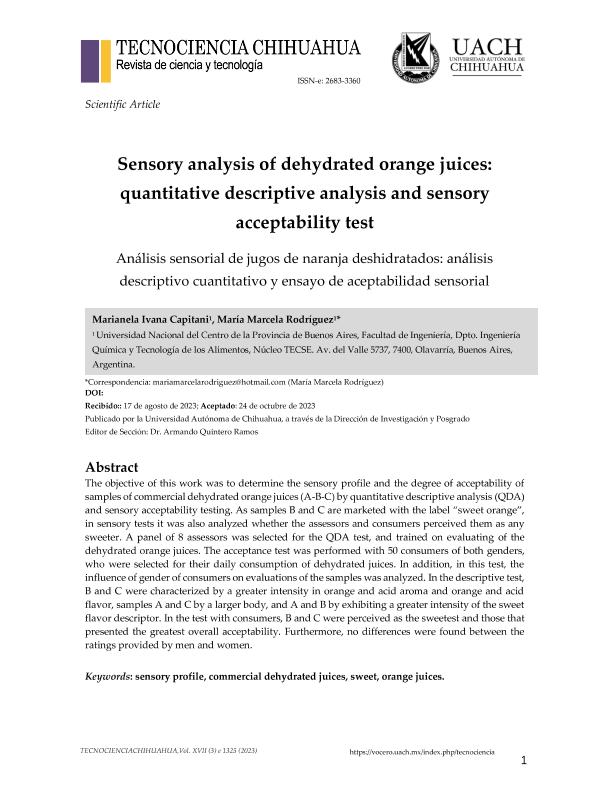Mostrar el registro sencillo del ítem
dc.contributor.author
Capitani, Marianela Ivana

dc.contributor.author
Rodriguez, Maria Marcela

dc.date.available
2024-01-31T14:37:41Z
dc.date.issued
2023-11
dc.identifier.citation
Capitani, Marianela Ivana; Rodriguez, Maria Marcela; Sensory analysis of dehydrated orange juices: quantitative descriptive analysis and sensory acceptability test; Universidad Autónoma de Chihuahua; Tecnociencia Chihuahua; 17; 3; 11-2023; 1-16
dc.identifier.issn
1870-6606
dc.identifier.uri
http://hdl.handle.net/11336/225370
dc.description.abstract
El objetivo de este trabajo fue determinar el perfil sensorial y el grado de aceptabilidad de muestras de jugos de naranja deshidratados comerciales (A-B-C) mediante análisis descriptivo cuantitativo (QDA por sus siglas en inglés) y pruebas de aceptabilidad sensorial. Como las muestras B y C se comercializan con la etiqueta “naranja dulce”, en los ensayos sensoriales también se analizó si los evaluadores y consumidores las percibían más dulces. Se seleccionó un panel de 8 evaluadores para el ensayo QDA, y se los entrenó en la evaluación de jugos de naranja deshidratados. El ensayo de aceptabilidad sensorial se realizó con 50 consumidores de ambos géneros, quienes fueron seleccionados por su consumo diario de jugos deshidratados. Además, en esta prueba se analizó la influencia del género de los consumidores en la valoración de las muestras. En el test descriptivo, B y C se caracterizaron por una mayor intensidad en aroma a naranja y ácido y sabor a naranja y ácido, las muestras A y C por un mayor cuerpo, y A y B por exhibir una mayor intensidad del descriptor sabor dulce. En el ensayo con consumidores, B y C fueron percibidas como las más dulces y las que presentaron mayor aceptabilidad global. Además, no se encontraron diferencias en la evaluación proporcionada por hombres y mujeres.
dc.description.abstract
The objective of this work was to determine the sensory profile and the degree of acceptability ofsamples of commercial dehydrated orange juices (A-B-C) by quantitative descriptive analysis (QDA)and sensory acceptability testing. As samples B and C are marketed with the label “sweet orange”,in sensory tests it was also analyzed whether the assessors and consumers perceived them as anysweeter. A panel of 8 assessors was selected for the QDA test, and trained on evaluating of thedehydrated orange juices. The acceptance test was performed with 50 consumers of both genders,who were selected for their daily consumption of dehydrated juices. In addition, in this test, theinfluence of gender of consumers on evaluations of the samples was analyzed. In the descriptive test, B and C were characterized by a greater intensity in orange and acid aroma and orange and acid flavor, samples A and C by a larger body, and A and B by exhibiting a greater intensity of the sweet flavor descriptor. In the test with consumers, B and C were perceived as the sweetest and those that presented the greatest overall acceptability. Furthermore, no differences were found between the ratings provided by men and women.
dc.format
application/pdf
dc.language.iso
eng
dc.publisher
Universidad Autónoma de Chihuahua
dc.rights
info:eu-repo/semantics/openAccess
dc.rights.uri
https://creativecommons.org/licenses/by-nc/2.5/ar/
dc.subject
SENSORY PROFILE
dc.subject
COMMERCIAL DEHYDRATED JUICES
dc.subject
SWEET
dc.subject
ORANGE JUICES
dc.subject.classification
Alimentos y Bebidas

dc.subject.classification
Otras Ingenierías y Tecnologías

dc.subject.classification
INGENIERÍAS Y TECNOLOGÍAS

dc.title
Sensory analysis of dehydrated orange juices: quantitative descriptive analysis and sensory acceptability test
dc.title
Análisis sensorial de jugos de naranja deshidratados: análisis descriptivo cuantitativo y ensayo de aceptabilidad sensorial
dc.type
info:eu-repo/semantics/article
dc.type
info:ar-repo/semantics/artículo
dc.type
info:eu-repo/semantics/publishedVersion
dc.date.updated
2024-01-30T15:41:17Z
dc.identifier.eissn
2683-3360
dc.journal.volume
17
dc.journal.number
3
dc.journal.pagination
1-16
dc.journal.pais
México

dc.journal.ciudad
Chihuahua
dc.description.fil
Fil: Capitani, Marianela Ivana. Universidad Nacional del Centro de la Provincia de Buenos Aires. Facultad de Ingeniería Olavarría. Departamento de Ingeniería Química; Argentina. Consejo Nacional de Investigaciones Científicas y Técnicas. Centro Científico Tecnológico Conicet - Tandil; Argentina
dc.description.fil
Fil: Rodriguez, Maria Marcela. Universidad Nacional del Centro de la Provincia de Buenos Aires. Facultad de Ingeniería Olavarría. Departamento de Ingeniería Química; Argentina. Consejo Nacional de Investigaciones Científicas y Técnicas. Centro Científico Tecnológico Conicet - Tandil; Argentina
dc.journal.title
Tecnociencia Chihuahua
dc.relation.alternativeid
info:eu-repo/semantics/altIdentifier/url/https://vocero.uach.mx/index.php/tecnociencia/article/view/1325
dc.relation.alternativeid
info:eu-repo/semantics/altIdentifier/doi/http://dx.doi.org/10.54167/tch.v17i3.1325
Archivos asociados
